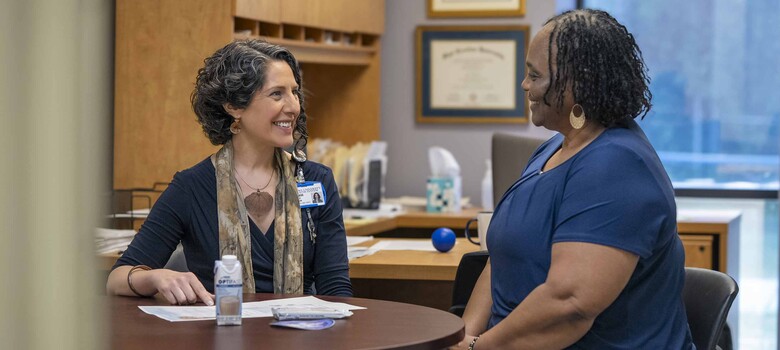 From the DukeHealth.org archives. Content may be out of date.
From the DukeHealth.org archives. Content may be out of date.
NC's First Bionic Eye Recipient Sees for First Time in 33 years

Larry Hester is the seventh person in the U.S. to have a so-called bionic eye - an Argus II Retinal Prosthesis Device -- implanted. It allows him to see for the first time in 33 years.
As the lights dimmed in the exam room, Larry Hester fixed his gaze forward and waited nervously. Paul Hahn, MD, a retinal surgeon at the Duke Eye Center, counted backward from three and pressed a button, activating Hester’s newly implanted bionic eye.
Hester startled.
“Yes!” he said, seeing a light for the first time since he became blind 30 years ago. “Oh my goodness. Yes!”
Hester, 66, was diagnosed with retinitis pigmentosa when he was in his early 30s. At the time, the degenerative disease that would rob his sight was poorly understood, and there were no known treatments.
But in the intervening years, there has been progress. On Oct. 1, 2014, Hester became only the seventh person in the United States to have a so-called bionic eye - an Argus II Retinal Prosthesis Device – activated as a visual aid to send light signals to his brain.

“Yes!” he said, seeing a light for the first time since he became blind 30 years ago. “Oh my goodness. Yes!”
Technology Developed at Duke Eye Center
The device incorporates technology initially developed by researchers then at the Duke Eye Center; its sophisticated features were further enhanced and marketed by a company called Second Sight Medical Products.
Using wireless technology, a sensor is implanted in the eye to pick up light signals sent from a camera mounted on special eyeglasses. Hahn implanted the sensor on Sept. 10, and activated the device on three weeks later – to the sheer delight of Hester and his family.
“Can I kiss him?” his wife, Jerry Hester, exclaimed in the moment she heard him say he saw flashing lights for the first time.
Hahn cautioned that the device will not restore normal eyesight , but instead provide a visual aid that could help Hester distinguish a door from a wall, or a crosswalk painted in a roadway. Hester describes seeing flashes of light that are more intense when he aims the camera at lights or light-colored objects.
During a clinic visit on Monday, Hester described “seeing” sights he had long believed were past memories – a white duck swimming in a pond, the harvest moon, his wife’s yellow chrysanthemums.
Jerry Hester said her most cherished moment came while they were watching a football game on Sunday. She was sitting in a dark chair, and her skin was enough of a contrast that Larry could see flashes. He reached out and touched her face.
“It was just a beautiful touch,” she said.
Hester will return to the Duke Eye Center regularly for additional training on the device, learning to discern shapes and objects from the flashes generated by the device. He said is eager to provide researchers with information they can use to enhance the technology, so that the next generation of patients will benefit from his pioneering effort.
“I just wonder how I have been so lucky,” he said. “Why me? But if I can use what I learn from this to help others with RP, it will not just be for my benefit.”
News Coverage
Watch and read some of the news coverage of this historic event:
NBC Today Show: After 30 years, blind man sees with bionic eye
News & Observer: NC's first recipient of bionic eye learns to see again


